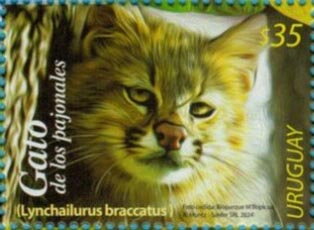Stamp: Pampas Cat (Lynchailurus braccattus) (Uruguay 2024)
Pampas Cat (Lynchailurus braccattus) (Uruguay 2024)
10 December (Uruguay ) within release M'Bopicuá Nature Reserve (2024) goes into circulation Stamp Pampas Cat (Lynchailurus braccattus) face value 35 Uruguayan new peso
| Stamp Pampas Cat (Lynchailurus braccattus) in catalogues | |
|---|---|
| Colnect codes: | Col: UY 2024.12.10-02a |
Stamp is square format.
stamp from mini-sheetAlso in the issue M'Bopicuá Nature Reserve (2024):
- Stamp - Black-Necked Swan (Cygnus melancoryphus) face value 35;
- Stamp - Broad-Snouted Caiman (Caiman latirostris) face value 35;
- Stamp - Collared Anteater (Tamandua tetradactyla) face value 35;
- Stamp - Cougar (Puma concolor) face value 35;
- Stamp - Great Horned Owl (Bubo virginianus) face value 90;
- Mini Sheet - Great Horned Owl (Bubo virginianus) face value 240;
- Stamp - Jaguar (Panthera onca) face value 90;
- Mini Sheet - M'Bopicuá Nature Reserve face value 240;
- Stamp - Pampas Cat (Lynchailurus braccattus) face value 35;
- Stamp - Pampas Deer (Ozotoceros bezoarticus) face value 35;
- Stamp - Paraguaian Hairy Dwarf Pporcupine (Sphiggurus spinosus) face value 35;
- Stamp - Plush-Crested jay (Cyanocorax chrysops) face value 35;
- Stamp - Red-Llegged Seriema (Cariama cristata) face value 35;
- Stamp - Roseate Spoonbill (Ajaja ajaja) face value 35;
Stamp Pampas Cat (Lynchailurus braccattus) it reflects the thematic directions:
Animals are multicellular, eukaryotic organisms of the kingdom Animalia (also called Metazoa). All animals are motile, meaning they can move spontaneously and independently, at some point in their lives. Their body plan eventually becomes fixed as they develop, although some undergo a process of metamorphosis later on in their lives. All animals are heterotrophs: they must ingest other organisms or their products for sustenance.
Mammals are any vertebrates within the class Mammalia (/məˈmeɪli.ə/ from Latin mamma "breast"), a clade of endothermic amniotes distinguished from reptiles (including birds) by the possession of a neocortex (a region of the brain), hair, three middle ear bones and mammary glands. All female mammals nurse their young with milk, secreted from the mammary glands. Mammals include the largest animals on the planet, the great whales. The basic body type is a terrestrial quadruped, but some mammals are adapted for life at sea, in the air, in trees, underground or on two legs. The largest group of mammals, the placentals, have a placenta, which enables the feeding of the fetus during gestation. Mammals range in size from the 30–40 mm (1.2–1.6 in) bumblebee bat to the 30-meter (98 ft) blue whale. With the exception of the five species of monotreme (egg-laying mammals), all modern mammals give birth to live young. Most mammals, including the six most species-rich orders, belong to the placental group. The largest orders are the rodents, bats and Soricomorpha (shrews and allies). The next three biggest orders, depending on the biological classification scheme used, are the Primates (apes and monkeys), the Cetartiodactyla (whales and even-toed ungulates), and the Carnivora (cats, dogs, seals, and allies).
A park is an area of natural, semi-natural or planted space set aside for human enjoyment and recreation or for the protection of wildlife or natural habitats. Urban parks are green spaces set aside for recreation inside towns and cities. National parks and country parks are green spaces used for recreation in the countryside. State parks and provincial parks are administered by sub-national government states and agencies. Parks may consist of grassy areas, rocks, soil and trees, but may also contain buildings and other artifacts such as monuments, fountains or playground structures. Many parks have fields for playing sports such as baseball and football, and paved areas for games such as basketball. Many parks have trails for walking, biking and other activities. Some parks are built adjacent to bodies of water or watercourses and may comprise a beach or boat dock area. Urban parks often have benches for sitting and may contain picnic tables and barbecue grills.



